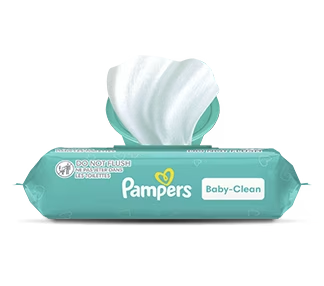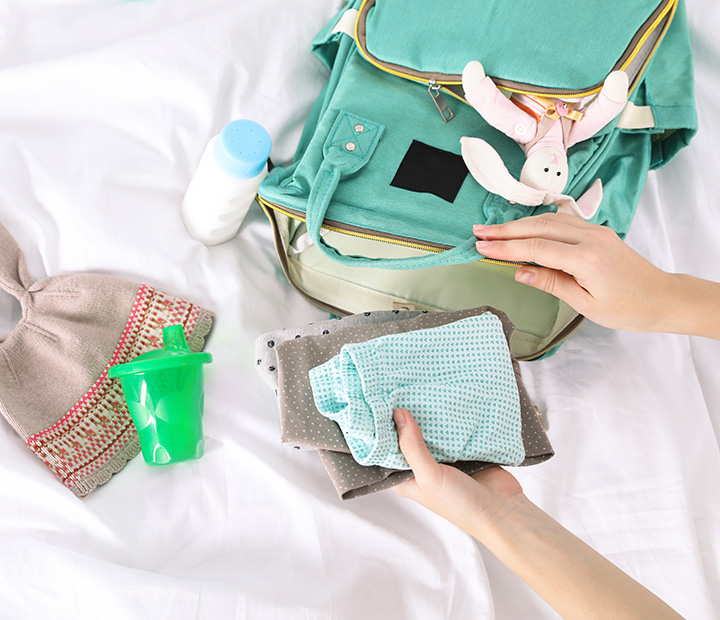Common Baby Rashes: Causes, Treatments & When to Seek Help
Your baby’s skin is delicate, so it’s not unusual to spot a baby rash now and then. In this guide, we’ll take a look at some of the most common types of baby rashes, including baby acne, eczema, and heat rash—plus ways you may help manage them.
While it’s not always possible to prevent rashes, there are a few simple steps that could reduce the chances of certain skin issues, like diaper rash. Read on to discover what causes a baby's skin rashes, how to recognize them, and practical tips for caring for your little one’s skin.
What Is a Rash?
A rash is a swelling or irritation of the skin making the skin appear red, bumpy, lumpy, or scaly. A rash may be itchy and sometimes accompanied by a fever. Some rashes, such as a rash on the baby’s face or the baby's stomach, might also be a sign of an allergic reaction, which could require immediate medical attention.
In this article, we’ll explore some of the most common types of baby rashes, but it’s important to know that not all rashes are covered here. If you have concerns about your little one’s skin—or if a rash doesn’t improve—it’s always a good idea to consult your baby’s healthcare provider.
What Can Cause Baby Rashes?
There are many reasons why a rash might appear on your little one’s skin, including:
Allergies, which may sometimes cause a baby's allergic reaction to rash from certain foods or environmental factors.
Irritation from products, like laundry detergents, which may lead to a newborn rash from detergent.
Friction and moisture, especially during teething, which may cause a teething rash on their body areas like the belly and back.
Insect bites
Bacterial, fungal, or viral infections
Heat and saliva buildup
How to Know If Your Baby Has a Rash?
Rashes in babies might appear in many forms, making it challenging to recognize them initially. Some signs to watch for include:
Spots on infant skin that might be red, pink, or even colourless bumps. For instance, colourless or raised bumps may sometimes be related to heat or irritation.
Dry patches on baby skin that feel rough to the touch, which might be due to moisture loss or mild irritation.
Each type of rash may look and feel different, so it’s important to monitor any changes. If a rash worsens or causes concern, consult your baby’s healthcare provider for guidance.
Baby Development Milestones Taking care of your baby is one of the most important responsibilities as a parent. Track your little one's development with our articles! Learn more
What Are the Most Common Rashes in Newborns and Babies?
As there are various types of rashes in babies, understanding how they vary could help you recognize and manage them more confidently. Below, we’ll go over common skin rashes in babies. We'll describe what each baby rash looks like, explore potential causes, and discuss baby skin rash treatment options to help soothe your little one's skin. Learning about these skin rashes in newborns may make it easier to care for and monitor your child’s skin health.
Diaper Rash
What does a baby diaper rash look like? Diaper rash is a red rash, sometimes with bumps, that may develop on your baby’s diaper area. Affected areas may include the lower abdomen, bottom, genitals, and folds of the thighs
What causes diaper rash? Diaper rash may be triggered by wet or soiled diapers being left on for too long or wearing a diaper that's too small. It might also be a reaction to something new, such as a different detergent used on cloth diapers or a new brand of diapers or wipes. Introducing new foods to your baby’s diet may also cause diaper rash, as changes in stool content and frequency of bowel movements could irritate the skin. Additionally, bacterial or yeast infections might lead to a diaper rash with white bumps in some cases.
Treatment: Diaper rash typically clears up in three to four days if what’s causing the rash is alleviated. To prevent or help clear diaper rash, change the wet or soiled diaper as soon as possible. Cleanse your baby’s diaper area with wipes or a washcloth and water, and expose your little one’s bottom to air whenever possible. You may also use diaper rash cream to create a barrier from moisture. Contact your baby’s healthcare provider if the rash is accompanied by a fever, if the rash doesn’t get better after a few days of trying the treatment methods mentioned above, or if the rash looks particularly bad.
Baby Acne
What does baby acne look like? Small red or white bumps might develop on your newborn’s face, usually on the cheeks, nose, and forehead. In some cases, baby acne all over the body may also appear such as on your little one's back and chest. It typically shows up between two to four weeks after birth.
What causes baby acne? The cause of baby acne is unknown.
Treatment: While baby acne treatment isn’t usually necessary, it helps to avoid using lotions or oils on your baby’s skin, as these may worsen the condition. Baby acne generally clears up on its own without leaving scars. In the meantime, gently cleanse your newborn’s skin with water and a mild baby cleanser.
Eczema
What does eczema in babies look like? When your little one has eczema, also known as atopic dermatitis, you may notice dry, scaly skin with red patches on areas like their face, the insides of the elbows, or behind the knees. An eczema rash in babies may appear after the first month and is often more common on the body than the face. These patches may range from mild to very itchy, which may cause discomfort for your baby.
What causes eczema? Both genetic and environmental factors contribute to eczema. Some babies inherit dry, sensitive skin, while others may develop eczema or baby heat rash due to their immune system’s reaction to environmental irritants like pollen. Allergies and sensitive skin may also increase the likelihood of baby eczema. Treatment: If you suspect your baby has eczema, pay a visit to their healthcare provider, who may prescribe a prescription ointment or an over-the-counter cream. To help treat eczema or prevent it from reoccurring, make sure to gently clean your baby's skin with mild, unscented cleanser and use mild, unscented laundry detergent; dress your baby in soft clothing; and bathe them no more than three times per week.
Hives
What do hives on babies look like? This itchy baby rash may appear as red, bumpy patches or welts with pale centres and might sometimes look like bug bites. Baby hives may show up in just one area or spread across the body, and they may even change locations from one hour to the next, making them challenging to track.
What causes hives? Hives in babies may be a symptom of
a virus
a food allergy, for example, an allergic reaction to peanuts, tree nuts, eggs, dairy, or shellfish
an allergic reaction to an over-the-counter or prescription medication
an allergic reaction to something your baby has touched, like soaps or plants
an insect bite or bee sting.
Treatment: A cool compress may help comfort the affected area. If your baby is having trouble swallowing or is wheezing, seek immediate emergency care, as your little one may be having an anaphylactic reaction.
Ringworm
What does ringworm look like? If it shows up on your baby’s scalp, it may cause temporary hair loss in that area. Ringworm might sometimes be mistaken for dandruff or cradle cap. If your baby is over 12 months old and has a scaly baby rash on their scalp, it’s more likely due to ringworm rather than cradle cap. Your baby’s healthcare provider may confirm the diagnosis.
What causes ringworm? Despite the name, this infection is not caused by worms. Instead, a fungus is responsible for ringworm in babies, which may appear on the scalp or other areas of the body. The infection spreads through person-to-person or animal-to-person contact. To prevent spreading, avoid sharing your little one’s combs, brushes, hair clips, or hats with others in the household.
Treatment: If you suspect ringworm, consult your baby’s healthcare provider, who may prescribe a cream or recommend an over-the-counter option for baby ringworm treatment. With proper treatment, ringworm should begin to clear up within about a week.
Food Allergy Rash
What does a food allergy rash look like? A baby food allergy rash may appear as hives, red, or dark patches on the skin and may sometimes be accompanied by vomiting or diarrhea, which are potential signs of a food allergy.
What causes a food allergy rash? As the name suggests, the rash may develop if your baby is allergic to a certain food.
Treatment: If you observe any of these symptoms, avoid the food that may have triggered the reaction and consult your baby’s healthcare provider.
For baby food allergy rash treatment, it’s best to remove the suspected allergen and seek advice at your next appointment. When introducing solid foods, try offering one new food at a time over three to five days to monitor for any signs of food allergies.
Cradle Cap
What does cradle look like? Technically known as seborrheic dermatitis cradle cap, may show up as scaly patches on your baby’s scalp in the first few weeks of their life. It might also appear elsewhere, such as on your baby’s neck, armpits, behind the ears, or even around the diaper area.
What causes cradle cap? While the exact cause is unknown, one theory is that babies get cradle cap due to the production of excess oil (sebum) in the oil glands and hair follicles, which may trap dead skin cells. A yeast (fungus) called Malassezia, which grows in the sebum along with bacteria might also contribute to the condition.
Treatment: If the condition is present on your baby’s scalp, washing their hair and softly brushing out the scales might help control the condition. Sometimes you may need a special shampoo prescribed by your baby’s healthcare provider to help clear it up. Cradle cap normally goes away within a few months.
Roseola
What does roseola look like? The symptoms of roseola, a contagious viral infection, include a pink or dark baby rash that may appear on your little one’s trunk and sometimes on their arms and neck. This rash on the baby's stomach or upper body usually follows a fever and cold- or flu-like symptoms. Roseola is most common in children under the age of 2. It typically takes about 10 days for the initial symptoms to appear after the point of infection
What causes roseola? Roseola is caused by a virus.
Treatment: If your baby has a fever, contact their healthcare provider for advice on how to bring down the fever.
Your little one’s healthcare provider may also recommend some tests like a blood count or urine analysis to help make a diagnosis.
When your little one has a fever, it’s best to keep them away from other children to prevent the spread of the infection.
Drool Rash
What does drool rash look like? Drool rash, also called lip licker’s contact dermatitis, is a form of eczema in which your baby’s saliva may irritate their skin and lips, creating a rash around the mouth.
What causes drool rash? Saliva from excessive drooling may cause this rash. This type of rash may happen when your baby is drooling a lot because of teething. For example, this is why it’s sometimes called a teething rash.
Treatment: To help with the baby drool rash treatment, wipe your little one’s face often if they’re drooling heavily. Using an absorbent bib that may be changed frequently will help keep the area clean and dry. You might also apply a barrier ointment, like petroleum jelly, to protect the skin. A cold compress may relieve any discomfort. If the drool rash is severe, oozing, or persistent, consult your baby’s healthcare provider for further recommendations.
Milia
What does milia look like? Milia in babies appears as tiny white or yellow spots on your newborn’s face, often on the cheeks, chin, or tip of the nose.
What causes milia? This condition occurs when skin flakes become trapped beneath the surface, resulting in these small bumps.
Treatment: Baby milia treatment isn’t typically necessary, as the bumps usually disappear on their own within the first two to three weeks. To care for baby milia, gently wash your baby’s face once a day with warm water and a mild cleanser. Avoid scrubbing or picking at the skin, and refrain from applying lotions or oils to the affected area, as this may irritate the skin further.
Scabies
What do scabies look like? Scabies in babies may appear differently depending on age. In infants, you may notice sparse, fluid-filled bumps often limited to the palms of the hands and soles of the feet. In older babies, these bumps may appear alongside reddish burrow tracks on the skin.
What causes scabies? The scabies rash is caused by microscopic mites that burrow into the skin, laying their eggs. The rash typically develops within about two to four weeks of the tiny mites laying their eggs.
Treatment: If you suspect scabies in your baby, consult their healthcare provider, who may perform a gentle skin scraping to test for mites. If scabies are confirmed, the provider will likely prescribe a lotion to be applied to the entire body. Since scabies spread easily, the healthcare provider may recommend that all family members undergo treatment to prevent reinfection.
Impetigo
What does impetigo look like? Impetigo in babies is a contagious infection that appears as a round, red or dark rash, typically on the nose, mouth, and ears. The rash often forms blisters that eventually crust over. As long as the rash is present, impetigo is contagious, so it’s important to keep your baby from close contact with other children and avoid touching the rash to help prevent the spread of the infection.
What causes impetigo? Impetigo may be caused by staphylococcal or streptococcal bacteria. The bacteria could enter the skin via a cut or an insect bite, but sometimes the infection may form on otherwise healthy skin.
Treatment: Your little one will need antibiotics to treat the infection, and their healthcare provider will order a test to find out which bacteria caused the infection, which will help determine the right course of treatment.
Miliaria
What does miliaria look like? You may see small red or dark bumps or sweat blisters in the folds of your baby's skin.
What causes miliaria? Also known as heat rash or prickly heat, miliaria typically happens in hot and humid climates, or if your baby is overheated from being overdressed.
Treatment: These bumps usually go away in a few days.
Erythema Toxicum
What does erythema toxicum look like? With this common rash, often called E. tox, your baby could have multiple red splotches with yellowish-white bumps. This type of rash appears in the first few days after your baby is born.
What causes erythema toxicum? The exact cause of this rash is unknown.
Treatment: The rash clears up on its own in about a week, though you may notice that it briefly goes away and then flares up again before clearing for good.
When to Consult Your Healthcare Provider?
While many rashes in babies are mild and may resolve with home care, some symptoms indicate it’s best to consult your baby’s healthcare provider. You should seek medical advice if:
The rash is accompanied by a fever, as this might signal an infection that may need medical attention.
The rash worsens, spreads, or doesn’t improve after a few days of at-home care.
You notice symptoms such as blisters, open sores, or oozing fluid, which could indicate a more serious infection or allergic reaction.
The rash appears infected, with signs like redness, warmth, swelling, or pus, which may require antibiotic treatment.
Your baby shows other signs of distress, such as difficulty breathing or swelling, which could suggest a severe allergic reaction or another urgent condition.
A healthcare provider may offer a proper diagnosis and recommend safe baby rash treatments if needed. If you’re ever in doubt, it’s always best to reach out to a medical professional.
FAQS AT A GLANCE
Heat rash looks like small red or darkened bumps or sweat blisters. It typically appears in the folds of your baby’s skin.
The Bottom Line
Noticing a baby rash on your little one’s skin may feel unsettling, especially if other symptoms appear too. Pinpointing the cause of the rash can be tricky, which is why it’s often best to consult your little one’s healthcare provider. They may help diagnose the baby rash and recommend safe, effective treatment—giving you peace of mind.
Soon enough, your baby’s skin will be smooth and kissable again, and you can get back to making them giggle with silly faces or blowing raspberries on their healthy skin.
If your baby has a diaper rash, using a well-fitting diaper that protects your baby's skin could help. Plus, don’t forget—you can be rewarded for all those diaper changes with the Pampers Rewards app.
How We Wrote This Article The information in this article is based on the expert advice found in trusted medical and government sources, such as the American Academy of Pediatrics and the American College of Obstetricians and Gynecologists. You can find a full list of sources used for this article below. The content on this page should not replace professional medical advice. Always consult medical professionals for full diagnosis and treatment.
Join Pampers Club and get:






